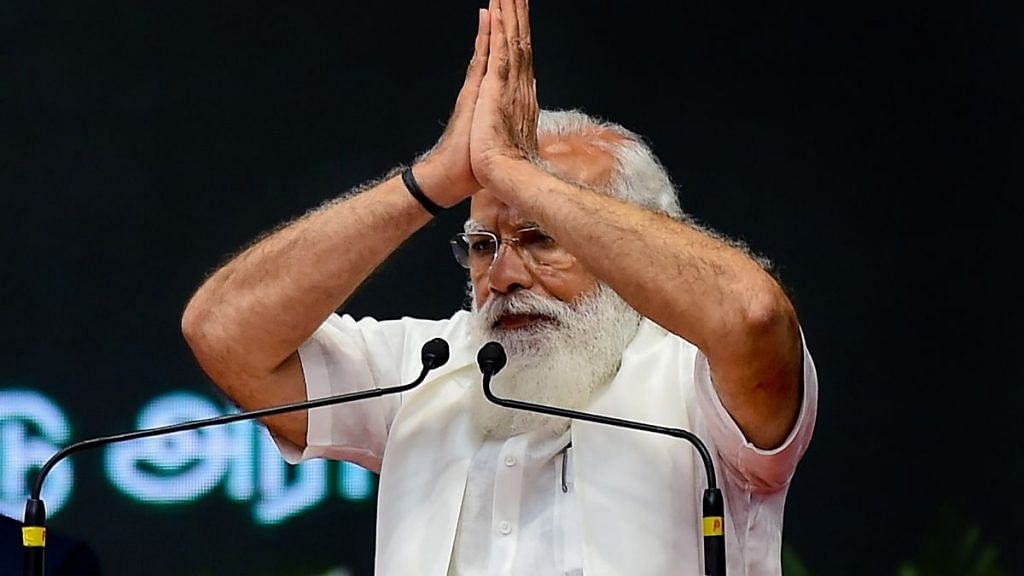Prime Minister Narendra Modi’s political and electoral success has one bedrock — his welfare schemes as well as development projects and their effective delivery. Yes, unabashed Hindutva and muscular nationalism are key to his politics, but these are not what win him elections. Modi’s ability to conceive schemes, execute projects with a wider reach has held him in good stead since he rose to power at the Centre in 2014.
ThePrint’s latest series on the flagship ‘Nal Se Jal’ programme reveals something similar — the scheme that aims to plug the gap of functional tap water connections has produced effective results on the ground. Of course, like all new programmes, this one has its fair share of teething problems as well, as our reporters found. But, Modi’s success lies in identifying areas where people lack basic necessities and then ensuring last-mile delivery to them. And this is what helps the Bharatiya Janata Party (BJP) win votes in elections.
From rural housing, cooking gas, rural electricity, bank accounts and now tap water — Modi’s model has been clear, and the results clearer. One may agree or disagree with his politics, or repelled by the polarisation tactics, but there is little denying that Modi knows the art of connecting with the voters. And he does that primarily by identifying what they need, and then creating a platform for it.
Also read: ‘Money is scarce’ — Modi govt set to axe about 40 schemes that ‘have lost relevance’
Hindutva and nationalism
The BJP wouldn’t be itself without its soul — brazen Hindutva. That is what catapulted the party to national prominence in the early 1990s and, make no mistake, it isn’t going anywhere. The BJP wears Hindutva on its sleeve and, in some cases, as an entire robe.
No election is ever complete without the Hindu-Muslim rhetoric — whether it’s the 2017 Uttar Pradesh assembly election with Modi’s ‘shamshaan-kabrisataan’ campaign driving it or the 2019 Lok Sabha election led by Home Minister Amit Shah’s CAA-NRC bogey. Besides the communal prism, nationalism too has become an important plank for the BJP. Anybody who doesn’t fit into the party’s scheme of things is ‘anti-national’ out to ‘break’ the country.
Despite being a credible vote-catching mechanism, Hindutva and nationalism are not the ultimate factor, otherwise the BJP under Atal Bihari Vajpayee would not have lost the 2004 Lok Sabha election so embarrassingly.
The main ingredient Modi added to his successful formula is delivering on his programmes — Hindutva and nationalism have merely acted as the masala that add zing to the dish.
Also read: Why India appears strangely silent on sky-high fuel prices
Welfare, delivery, development
That welfare and development would be key was made clear in early 2018, when Modi told leaders from 14 BJP-ruled states to accelerate the implementation of welfare schemes, and emphasised the importance of meeting the set targets of flagship programmes.
Modi’s first term was about introducing schemes for the needy — the Pradhan Mantri Awaas Yojana, Saubhagya Yojana, Ujjwala, Ayushman Bharat, Jan Dhan Yojana and more. Each of these formed the bouquet that helped catapult Modi back to power in 2019 with an even bigger mandate than five years ago.
The Congress, in its ten years in power heading the United Progressive Alliance, had perhaps just one such marquee programme — MGNREGA. And even this scheme, which gave a definite boost to the party in 2009, started fading during UPA 2, ridden with gaps, flawed implementation and ghost beneficiaries.
In Modi’s case, the trick wasn’t just to identify what people wanted from the government, but also be able to give it to them. Take, for instance, rural housing. As Indira Awaas Yojana, the scheme was full of deficiencies. But as the repackaged PMAY-G, it saw the output being doubled in just two years.
While covering assembly elections in Tripura, Uttar Pradesh and Madhya Pradesh from the ground, I met voters who said they wanted to see the BJP back in power because of the Centre’s programmes. Very few cited muscular nationalism or Hindutva as the reason. Of course, these factors always play a part, but there is little denying that the delivery plank Modi carefully crafted won him elections.
In his second term, governance seemed to be getting lost somewhere, in the din of political noise. But Modi is perceptive and clever. He knows a Ram Temple may give him a fillip, but cannot win him an election beyond perhaps Uttar Pradesh. The ‘Nal Se Jal’ report card seems largely positive, albeit with gaps and much scope for improvement. My colleague Moushumi Dasgupta, who travelled on the ground to report on the scheme, found it to have changed the lives of rural poor, especially those belonging to underprivileged SC/ST communities. She also found appreciation for the Centre for bringing this scheme — much like the response PMAY(G) and Ujjwala schemes invoked.
Notice the major infrastructure push for poll-bound states in Budget 2021, as well as the slew of projects that the PM is inaugurating in a frenzy across these states, and the pattern becomes evident.
One may want to believe that Modi is all about Hindutva and flaunting a ’56-inch chest’. But alongside the sensational and emotive, often polarising, elements of communalism and nationalism lies the core that Modi knows is crucial to maintaining his political grip — delivering on what matters to voters the most. Call it chulha, makaan and paani, his unique turn on on roti, kapda and makaan.
Views are personal.
